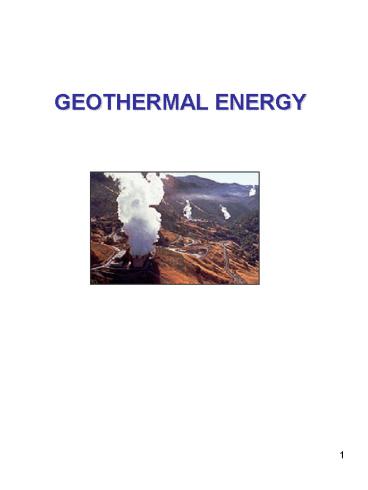GEOTHERMAL ENERGY - PowerPoint PPT Presentation
1 / 29
Title:
GEOTHERMAL ENERGY
Description:
GEOTHERMAL ENERGY Geothermal power is generated by mining the earth's heat. In areas with high temperature ground water at shallow depths, wells are drilled into ... – PowerPoint PPT presentation
Number of Views:220
Avg rating:3.0/5.0
Title: GEOTHERMAL ENERGY
1
GEOTHERMAL ENERGY
2
Geothermal power is generated by mining the
earth's heat. In areas with high temperature
ground water at shallow depths, wells are drilled
into natural fractures in basement rock or into
permeable sedimentary rocks. Hot water or steam
flows up through the wells either by pumping or
through boiling (flashing) flow. Experiments are
in progress to determine if a fourth method, deep
wells into "hot dry rocks", can be economically
used to heat water pumped down from the surface.
A hot dry rock project in the United Kingdom was
abandoned after it was pronounced economically
unviable in 1989. HDR programs are currently
being developed in Australia, France, Switzerland
and Germany. Magma (molten rock) resources offer
extremely high-temperature geothermal
opportunities, but existing technology does not
allow recovery of heat from these resources.
3
(No Transcript)
4
People who live in these areas are receiving
electricity from geothermal power plants
5
(No Transcript)
6
This historical drawing depicts Native Americans
using hot springs at what is now Calistoga,
California. Some tribes considered hot springs to
be neutral territory where no wars were allowed.
This small greenhouse is heated with geothermal
water. Plants grow faster and larger when they
have additional heat available
7
Geothermal water is also used for industrial
uses, like drying lumber or food products. This
plant in Brady, Nevada, provides dried onions to
Burger King
Pipes of geothermal water can be installed under
sidewalks and roads to keep them from icing over
in winter, like this sidewalk in Klamath Falls,
Oregon
8
There are three geothermal power plant
technologies being used to convert hydrothermal
fluids to electricity. The conversion
technologies are
dry steam,
Flash
binary cycle
The type of conversion used depends on the state
of the fluid (whether steam or water) and its
temperature.
9
Dry Steam Power Plants
Steam plants use hydrothermal fluids that are
primarily steam. The steam goes directly to a
turbine, which drives a generator that produces
electricity
It was first used at Lardarello in Italy in 1904,
and is still very effective
10
(No Transcript)
11
The first modern geothermal power plants were
also built in Lardello, Italy. They were
destroyed in World War II and rebuilt. Today
after 90 years, the Lardello field is still
producing.
The first geothermal power plants in the U.S.
were built in 1962 at The Geysers dry steam
field, in northern California. It is still the
largest producing geothermal field in the world.
12
Flash Steam Power Plants
Hydrothermal fluids above 360F (182C) can be
used in flash plants to make electricity. Fluid
is sprayed into a tank held at a much lower
pressure than the fluid, causing some of the
fluid to rapidly vaporize, or "flash." The vapor
then drives a turbine, which drives a generator.
If any liquid remains in the tank, it can be
flashed again in a second tank to extract even
more energy.
13
Flash technology was invented in New Zealand.
Flash steam plants are the most common, since
most reservoirs are hot water reservoirs. This
flash steam plant is in East Mesa, California.
14
This flash plant is in Japan. In flash plants,
both the unused geothermal water and condensed
steam are injected back into the periphery of the
reservoir to sustain the life of the reservoir.
15
Binary-Cycle Power Plants
Most geothermal areas contain moderate-temperature
water (below 400F). Energy is extracted from
these fluids in binary-cycle power plants. Hot
geothermal fluid and a secondary (hence,
"binary") fluid with a much lower boiling point
than water pass through a heat exchanger. Heat
from the geothermal fluid causes the secondary
fluid to flash to vapor, which then drives the
turbines
16
(No Transcript)
17
Binary technology allows the use of lower
temperature reservoirs, thus increasing the
number of reservoirs that can be used. This
binary plant is at Soda Lake, Nevada
18
This binary power plant, at Wendell-Amadee,
California, runs by itself. If it detects a
problem, it automatically radios the operator to
come to the site
19
(No Transcript)
20
(No Transcript)
21
(No Transcript)
22
(No Transcript)
23
These geothermal plants are operating
successfully in a Philippine cornfield, at
Mammoth Lakes, Calif., in the Mojave Desert of
California, and in a tropical forest, at Mt. Apo,
Philippines.
24
Turbine generator outdoors at an Imperial Valley
geothermal power plant in California
25
Turbine generator in a geothermal power plant in
Cerro Prieto, Mexico
26
(No Transcript)
27
(No Transcript)
28
(No Transcript)
29
The Future of Geothermal Electricity
Steam and hot water reservoirs are just a small
part of the geothermal resource. The Earth's
magma and hot dry rock will provide cheap, clean,
and almost unlimited energy as soon as we develop
the technology to use them. In the meantime,
because they're so abundant, moderate-temperature
sites running binary-cycle power plants will be
the most common electricity producers. Before
geothermal electricity can be considered a key
element of the U.S. energy infrastructure, it
must become cost-competitive with traditional
forms of energy. The U.S. Department of Energy is
working with the geothermal industry to achieve
0.03 to 0.05 per kilowatt-hour.































